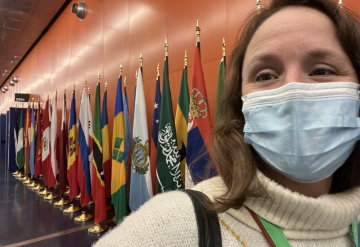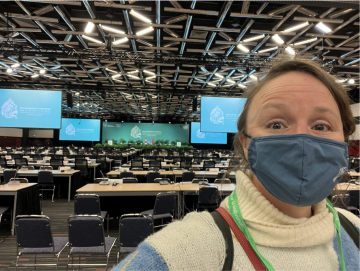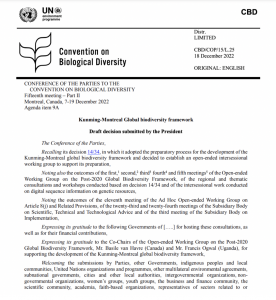Associate Director of Sustainability and Community Programs, UBC Botanical Garden, Tara Moreau shares her insights into the historic signing of the Kunming-Montreal Global Biodiversity Framework in December of 2022 in conversation with Garden staff member Lauren Jackson.

Tara arrives to a blanket of snow over the COP-15 proceedings in Montreal.
In the early morning hours of December 20th, 2022, after weeks of negotiations and compromise across diverse histories, values, privileges and stories, the Kunming-Montreal Global Biodiversity Framework was adopted by 196 parties. The Biodiversity Framework, years in the making and delayed significantly by the pandemic, set a strategic, international plan for biodiversity to the year 2030, with a long-term vision to 2050.
Associate Director Tara Moreau had an opportunity to witness this historic event and shares her insights into how this international plan at the scale of global change was agreed to by almost 200 parties.

Tara in front of some of the flags representing the 196 countries attending the conference.
What is the Biodiversity Framework and why is it important?
The biodiversity framework is a unifying agreement that highlights 4 goals to guide governments, institutions, organizations, and individuals in their work to protect biodiversity, setting targets for nations and signatories to deliver on. Unlike the Paris Accord (the International Treaty on Climate Change), the Biodiversity Framework is not legally binding. Regardless, the framework will have a tremendous global impact as it informs future policies created by governments, organizations, institutions, and individuals.
Tara attended COP-15 as part of the academic and research cohort of delegates. She has followed the creation of the framework since 2018, and when the opportunity arose for her to see it signed in person, on Canadian soil, she jumped at the chance! The early drafts of the framework and Tara’s vision to localize the framework’s global goals and raise awareness of plant conservation form the foundation of the educational curriculum for UBC Botanical Garden’s annual Biodiversity Days.
What did the process look like to create the final framework?
Tara arrived towards the end of the two week conference, when all the final decisions get made. Leading up to the event were years of meetings with working groups to create draft frameworks that formed the foundational documents from which the conference delegates worked.
Delegates at COP-15 included ministers of agriculture, environment, and other appointed national representatives who descended on Montreal for two weeks with the goal to reach agreement on the framework. This negotiation process involved removing brackets — leading up to the conference, any element of the framework that needs negotiation, correction or collaboration was outlined in [two brackets just like this]. Over the course of the conference, small groups of delegates worked to remove as many brackets as possible by coming to consensus on word choice. Once this was done, the agreed on section was presented in an enormous room – called the Plenary – where nationally-appointment delegates got the final say on wording and language. In a lot of ways, it was like a giant, international group project. In the early morning of December 20th, an important milestone was reached and a bracket-free document was ready to sign.

Delegates forming one of many working groups gathered in a breakout room, collaborating on eliminating brackets from the document and advancing science-informed decisions.

Tara standing at the back of the Plenary – the huge conference room where delegates gather to make decisions on the framework.
How does it feel to see this process happen in real-time?
Tara said it was an honour to attend and witness the negotiations. She said that bringing together high level decision makers with community advocates and Indigenous leaders was an important learning experience. The challenge of our time is to address the interconnected issues of biodiversity extinction, climate change and social justice. While this gathering was not always successful at bridging these differences, and the Biodiversity Framework has its critics, collective learning based on science and other ways of knowing is key to conserving cultural and biological diversity.
Tara also expressed how seeing all of this come together felt like an injection of hope. As this framework, and the importance of biodiversity is something she has been advocating for so long, it was exciting to see people from around the world rally for nature and the Rights of Indigenous People. She notes that while working on the climate and extinction crises is not always hopeful and can feel very disheartening, participating in this event felt like seeing climate justice in action.
What does this mean to UBC Botanical Garden and plant conservation?
The next and most important step is for all of us to continue this tidal wave of work around biodiversity. In the global conservation community, this will mean updating the Global Strategy for Plant Conservation to align with the Biodiversity Framework. At a local level, this will mean using the framework to inform educational, engagement, and research efforts at UBC Botanical Garden.
Tara notes that aside from this wave of policy momentum, the other most impactful way to keep up the energy generated by COP-15 is to keep people engaged and active in translating scaling effects across disciplines, institutions and communities. Right now, 2 in 5 plants are facing extinction which is something that happens silently, right under our noses. Tara hopes that the noise generated from this conference around biodiversity, Indigenous Rights and halting extinction will renew our hope of living in harmony with nature.

The Kunming-Montreal Global Biodiversity Framework was adopted at the 15th Conference of Parties (COP-15) of the UN Convention on Biological Diversity in Montreal Canada in December 2022.
Submitted by Tara Moreau and Lauren Jackson
